Vega Evolution
Launchers and Propulsion
Vega Launcher Evolution
Vega-C Proof of Concept References
On November 30, 2017, ESA signed two contracts today with Italy's ELV (European Launch Vehicle) and Thales Alenia Space to extend Europe's Vega space system capabilities and competitiveness, and develop Space Rider for a payload return capability. ELV S.p.A., the prime contractor of Vega development, is a company established by Avio and ASI (Italian Space Agency) in December 2000. 1)
ELV will develop and extensively test a new European cryogenic upper stage engine development model for Vega evolutions beyond 2025, based on low-cost liquid oxygen–methane propulsion.
The engine replaces the current Zefiro-9 solid-propellant motor and the AVUM upper stage engine for Vega-E, matching Vega-C performance at significantly reduced costs and improved flexibility.
In addition, complementing the SSMS (Small Spacecraft Mission Services) program already under development, ELV will investigate how existing motors such as the P120, P80, Z40, Z23, Z9, could be used to create a family of Vega-E configurations able to place payloads of 200–2500 kg into orbit. - This will incorporate promising technologies in the areas of 3D layer-by-layer additive manufacturing, hydrogen peroxide as low-toxicity propulsion, and advanced avionics, offering competitive production and operational costs.
The contract concerning the Vega evolution activities worth €53 million was signed by ESA Director of Space Transportation Daniel Neuenschwander and ELV Managing Director Andrea Preve at ESA headquarters in Paris. - In parallel, Thales Alenia Space and ELV will complete the detailed mission and system design up to the CDR (Critical Design Review) for Space Rider.
At the ESA Ministerial meeting in December 2014, Member States agreed to begin developing the more powerful Vega-C, now expected to debut mid-2019, with the main objectives:
• to strengthen Vega's position in the market in the short to medium term
• to increase launch vehicle performance by at least 300 kg and increase the flexibility for multiple payloads missions
• to be able to introduce the Vega-C configuration to the market from end-2018 at a cost no higher than today's Vega, profiting from the shared development with Ariane 6 of the first-stage motor
• to reduce the dependency on non-European sources in launcher production at no extra cost
• to respond better to long-term institutional needs
• to help maintain European industrial engineering capabilities, particularly in propulsion, in parallel to the Vega and Vega-C exploitation.
Additional improvements are being studied to enable Vega to carry micro- and nanosatellites in order to be cost-effective in this emerging market.
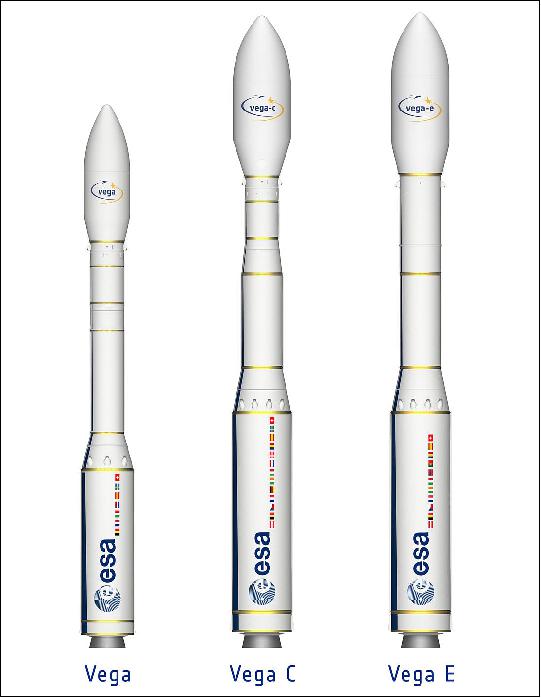
The Space Rider space transportation system will be integrated with Vega-C, combining an Orbital Service Module derived from a Vega-C AVUM (Attitude Vernier Upper Module) and a reentry module derived from the IXV (Intermediate eXperimental Vehicle) demonstrator flown in 2015 on Vega.
It will provide Europe with an affordable reusable platform for routine access and return from space, with payloads capacity up to 800 kg to an array of orbit altitudes and inclinations for multiple applications such as advanced microgravity, in-orbit demonstration and validation for Earth observation, science, telecommunication and robotic exploration.
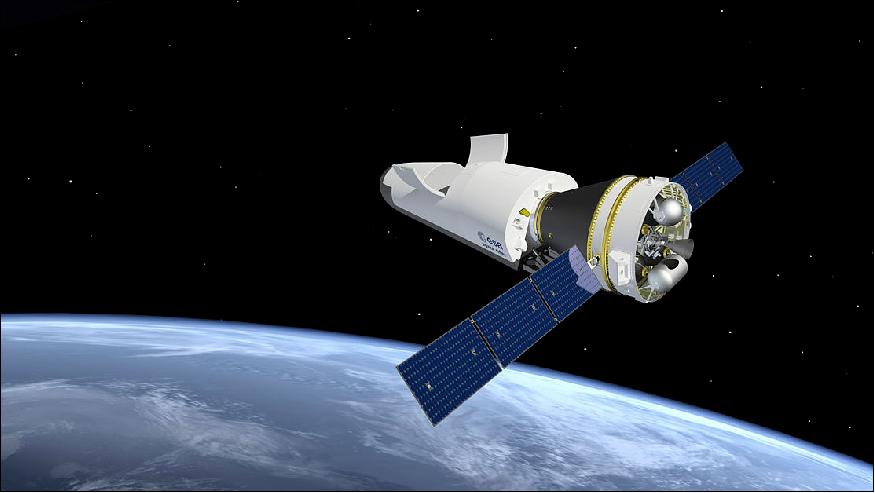
The Space Rider design builds on technological and industrial knowhow from Vega, Vega-C and the IXV development and demonstrations. The contract for Space Rider activities, worth €36.7 million, was signed by ESA Director of Space Transportation Daniel Neuenschwander, Thales Alenia Space Vice President Domain Exploration and Science Walter Cugno, and ELV Managing Director Andrea Preve at ESA headquarters in Paris.
The Vega and Space Rider development programs provide the framework to consolidate a Vega space system able to capture the broadest market needs with Vega-C and its spin-offs products: SSMS, Space Rider, and the VEnUS (Vega Electric Upper Stage), covering access to LEO (Low Earth Orbit) for payloads up to 2300 kg, orbital transfer from LEO, and return from LEO, for a multitude of space applications in a competitive manner.
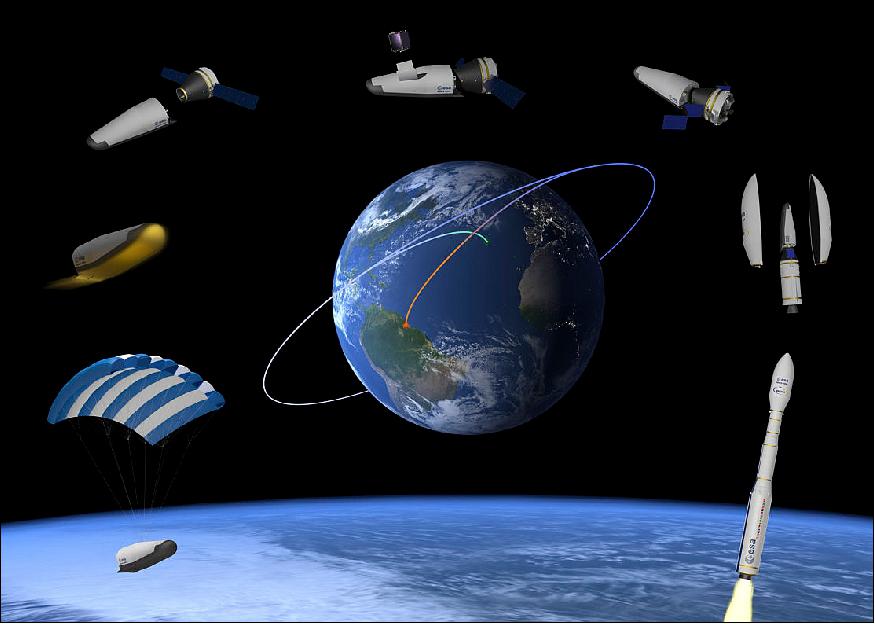
Vega-C
On the wave of Vega's success, Member States at the ESA Ministerial meeting in December 2014 agreed to develop the more powerful Vega-C to respond to an evolving market and to long-term institutional needs. Vega-C is expected to debut in mid-2019, increasing performance from Vega's current 1.5 ton to about 2.2 ton in a reference 700 km polar orbit, covering identified European institutional users' mission needs, with no increase in launch service and operating costs. 4)
The participating states in this development are: Austria, Belgium, Czech Republic, France, Germany, Ireland, Italy, Netherlands, Norway, Romania, Spain, Sweden and Switzerland.
The main objectives are to increase performances, reduce operating costs, provide cost-efficient launch services and reduce the dependency on non-European sources in launcher production at no extra cost.
Elements
Vega-C is based on the existing Vega launcher and comprises four stages. Three stages will use solid-propellant motors and one will use liquid propellants.
The first stage is based on the P120C, the largest monolithic carbon fiber solid-propellant rocket motor ever built. Its development relies on new technologies derived from those of P80, Vega's current first stage motor and will provide a significant increase in performance. The P120C will also be used for the liftoff boosters on Ariane 6.
The second stage with the new Zefiro-40 (Z40) motor will contain about 36 tons of solid propellant providing an average thrust of 1100 kN.
The Zefiro-9 third stage, currently used on Vega, burns 10 tons of solid propellant.
The AVUM+ upper stage for orbital positioning and attitude control is derived from the current Vega AVUM but has a lighter structure. It carries more propellant inside larger tanks and features several new European-developed components. AVUM+ has a propellant mass of 0.74 tons and the main engine will provide an average thrust of 2.45 kN.
A larger fairing with an increased payload envelope (3 m in diameter) to accommodate larger satellites is also being developed. It will be suitable for Earth observation satellites of more than two tons, and the Space Rider reentry vehicle.
The total length of Vega-C is about 35 m with a mass at liftoff of 210 tons – a significant increase over the current Vega's 130 tons.
Vega-C will be launched from the same site used for Vega at Europe's Spaceport in Kourou, French Guiana.
Way Forward
ESA is overseeing the procurement and the architecture of the overall launch system, while industry is building the rocket with ELV S.p.A. as prime contractor. An industrial cooperation agreement has been signed between ASL (Airbus Safran Launchers) and Avio for the P120C solid motor.
The SDR (System Definition Review) of the Vega-C launch system has been completed and the development activities are proceeding as planned. The CDR (Critical Design Review) of the launch system is planned for the end of 2018, and the Ground Qualification Review in the first quarter of 2019.
The evolution requires modifications to the Vega launch pad and mobile gantry, such as a more powerful crane, new pallets, and modified fluid services. These modifications are being made in such a way to keep the pad and gantry compatible with both vehicles during the period when launches of Vega will be alternated with Vega-C.
Vega SSMS POC (Proof of Concept) Flight
• November 23, 2018: A proof of concept flight on Vega of the SSMS (Small Spacecraft Mission Service) is planned for mid-2019. 5) 6)

- Vega offers more low cost ride-share launch opportunities into low Earth orbit for small satellites below 500 kg, from CubeSats to microsats and minisats, technology demonstrators to mega-constellations. This service is based on a range of specially developed dispensers which will allow launch operator Arianespace at Europe's Spaceport in Kourou, French Guiana to optimize Vega launch capacities.
- Following this, a consolidated Vega, Vega-C will take its first flight at the end of 2019 to carry larger, heavier payloads up to 2300 kg.
- It has new more powerful first and second stage motors, the P120C and Zefiro-40 respectively, providing the thrust at liftoff. Both motors were successfully tested this summer.

- A larger, lighter fairing has been developed with new materials and manufacturing techniques.
- ESA's Space Rider reentry vehicle will be launched on Vega-C. It will provide an in-orbit platform for payloads of up to 800 kg.
- Its Orbital Service Module, a modified version of the Vega-C AVUM+, extends the time that can be spent in orbit by at least two months before Space Rider returns with its cargo to Earth to land on ground.
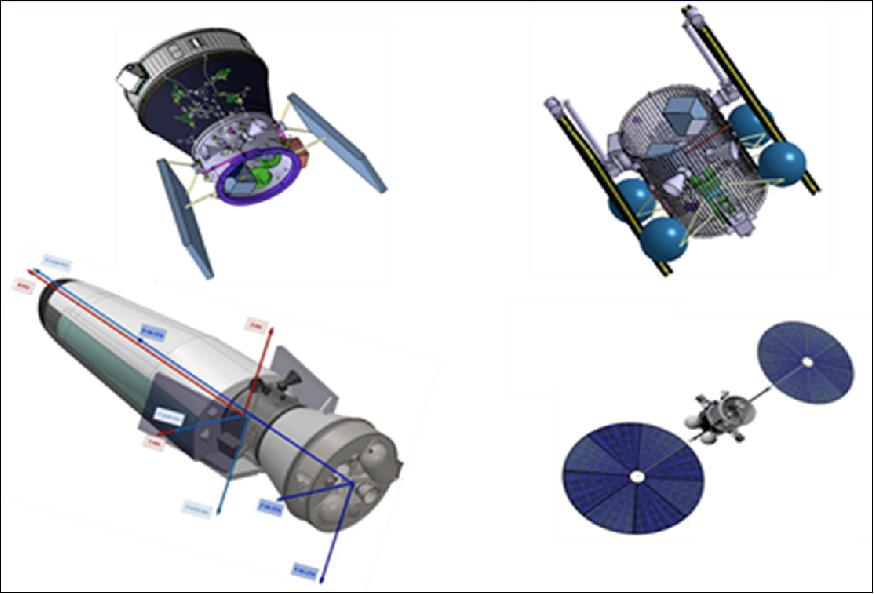
- An evolution of Vega, Vega-E, with a family of configurations based on common building blocks will further increase competitiveness beyond 2025.
- Recent tests have included the hot firing of the subscale thrust chamber of the upper stage M10 engine. Tests of the fullscale thrust chamber are planned for next year.
• June 21, 2018: With just one year before Vega-C lifts off from Europe's Spaceport in French Guiana, preparations for Europe's next launcher are gaining momentum. 7)
- Vega-C will increase performance from Vega's current 1.5 t to about 2.2 t hauled to its reference 700 km polar orbit, with no increase in launch costs.
- Thrust in the first phase of flight comes from new solid-fuel first and second stage motors, P120C and Zefiro-40, respectively.
- P120C's upcoming first hot static-firing test at Europe's Spaceport will prove the design, new materials, techniques, tools and components.
- Developed by Europropulsion under contract to Avio and ArianeGroup, P120C is 13.5 m long and 3.4 m in diameter – the largest solid-propellant motor ever built in one segment. Two or four will also be used for Ariane 6.
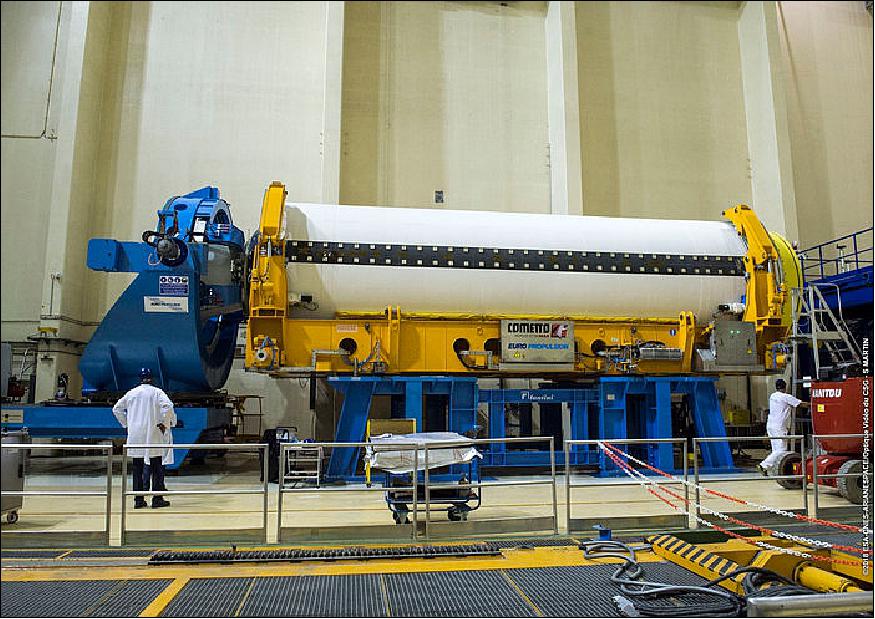
- Zefiro-40, developed and manufactured by Avio in their Colleferro factory, was static fired on 8 March in Sardinia. The resulting test data will guide the qualification and flight models design.
- The AVUM+ upper stage, derived from the current Vega AVUM, has been improved. The liquid propellant capacity has been increased by about 150 kg and the structure has been optimized by using carbon composite sandwich panels. Developed by AVIO, it will improve the flexibility of the launcher to deploy one or more payloads thanks to its 2.45 kN main engine and new avionic equipment.
- Vega-C's 3.3 m diameter fairing can accommodate larger payloads. An ‘out-of-autoclave' manufacturing technique developed by Ruag Space in Switzerland reduces cost, saves time and enables production of very large composite panels.
- Electromechanical thrust vector control systems that guide and control the vehicle stages at each phase of flight are in development, harnessing leading-edge manufacturing processes to enhance performance.
- The Vega launch pad and mobile gantry are being modified to accommodate Vega-C requiring a more powerful crane, new pallets, and modified fluid services.
• On 31 May 2018, Arianespace announced that ISIS (Innovative Solutions In Space) has joined the group of customers who have signed contracts to launch payloads on Vega's SSMS (Small Spacecraft Mission Service) POC (Proof Of Concept) flight in early 2019. — ISIS' small satellites will be orbited on Vega from the Guiana Space Center, Europe's Spaceport in Kourou, French Guiana. 8)
- The contract was signed with ISL (Innovative Space Logistics B.V.), the launch services subsidiary of ISIS. This agreement includes a QuadPack deployer for multiple CubeSats on the Vega SSMS POC flight, along with options for several microsatellites and more QuadPack deployers for the SSMS POC mission – as well as for subsequent Vega SSMS launches.
- ISIS is a leading company in the small satellite market. Founded in 2006, it specializes in realizing innovative turnkey small satellite missions – including launch and operations. ISIS designs and delivers small satellite platforms for single missions and constellations, either standardized or optimized in performance and size tailored to the needs. Through its ISL launch services subsidiary, ISIS has launched more than 270 small satellites of various sizes.
- The small satellite launch services covered by the ISIS agreement with Arianespace opens the way for more intense future collaboration between the two companies in launching clusters of small satellites integrated by ISIS through Arianespace.
- The Vega Proof Of Concept flight is the first mission of the Small Spacecraft Mission Service (SSMS) program initiated in 2016 by ESA (European Space Agency), with the contribution of the European Commission. For all the European partners involved, its purpose is to accurately address the promising "New Space" microsatellite market with a new rideshare concept on the Vega light-lift launcher.
• April 17, 2018: Arianespace announced today that it has been selected by leading rideshare and mission management provider Spaceflight to launch small satellites on the Vega launch vehicle, as part of the SSMS (Small Spacecraft Mission Service) POC (Proof Of Concept) flight. 9)
- Arianespace has signed a landmark agreement with Spaceflight Industries for the launch of several small payloads. This will be the inaugural mission for Spaceflight customer spacecraft on an Arianespace vehicle.
- The initial batch of spacecraft is slated for launch aboard Vega in early 2019 from Europe's Spaceport at the Guiana Space Center. The contract with the Seattle-based Spaceflight Industries covers a microsatellite and a significant number of cubesats to be launched on the Small Spacecraft Mission System (SSMS) POC flight as well as on a subsequent Vega SSMS flight about one year later.
References
1) "Vega Evolution preparation and Space Rider development," ESA, 30 Nov. 2017, URL: http://m.esa.int/Our_Activities/Space_Transportation/
Vega_Evolution_preparation_and_Space_Rider_development
2) "Vega/Launch Vehicles/Space Transportation," ESA, 10 May, 2017, URL: http://m.esa.int/Our_Activities/
Space_Transportation/Launch_vehicles/Vega
3) "Vega configurations," ESA, 28 Nov. 2017, URL: http://m.esa.int/spaceinimages/Images/2017/11/Vega_configurations
4) "Vega-C, launchers to space," ESA, 4 July 2017, URL: http://m.esa.int/Our_Activities/Space_
Transportation/Launch_vehicles/Vega-C
5) "Focus on Vega developments," ESA Space Transportation, 23 November 2018, URL: http://m.esa.int/Our_Activities/Space_
Transportation/Focus_on_Vega_developments
6) Giorgio Tumino, "The VEGA Space Transportation System Development: Status and Perspectives," Proceedings of the 69th IAC (International Astronautical Congress) Bremen, Germany, 1-5 October 2018, paper: IAC-18.D2.1.3, URL: https://iafastro.directory/iac/proceedings/IAC-18/
IAC-18/D2/1/manuscripts/IAC-18,D2,1,3,x48506.pdf
7) "European industry gears up for Vega-C debut in 2019," ESA, 21 June 2018, URL: http://www.esa.int/Our_Activities/Space_Transportation
/European_industry_gears_up_for_Vega-C_debut_in_2019
8) "Arianespace and ISIS to Launch Small Satellites on the Vega SSMS POC Flight," SpaceRef, 31 May 2018, URL: http://spaceref.com/news/viewpr.html?pid=52641
9) "Arianespace and Spaceflight sign contract to launch small satellites on Vega SSMS POC flight," Arianespace, 17 April 2018, URL: http://www.arianespace.com/press-release/arianespace-and-
spaceflight-sign-contract-to-launch-small-satellites-on-vega-ssms-poc-flight/
The information compiled and edited in this article was provided by Herbert J. Kramer from his documentation of: "Observation of the Earth and Its Environment: Survey of Missions and Sensors" (Springer Verlag) as well as many other sources after the publication of the 4th edition in 2002. - Comments and corrections to this article are always welcome for further updates (eoportal@symbios.space).